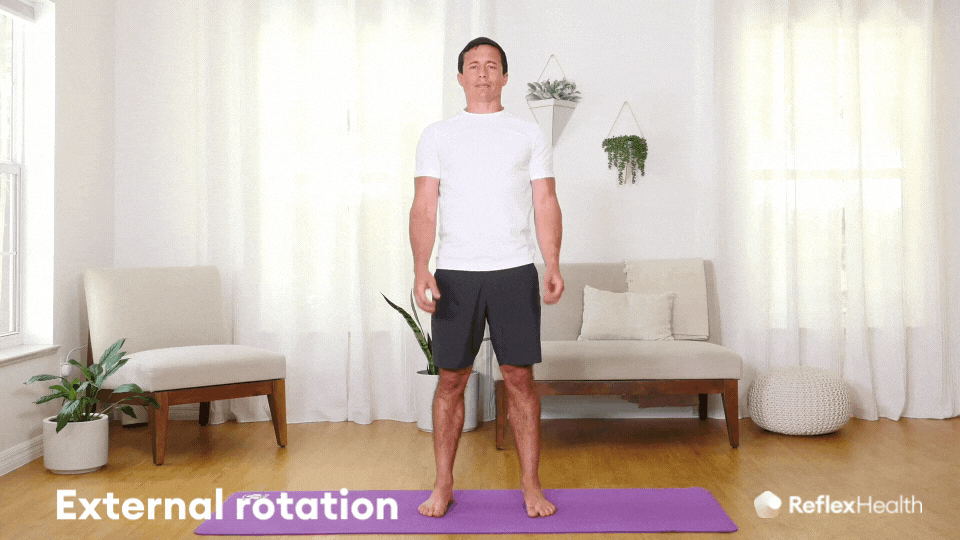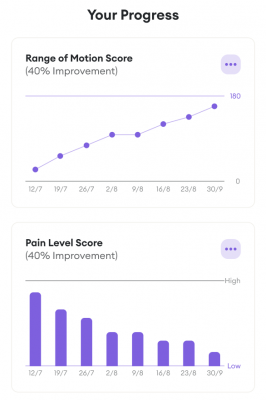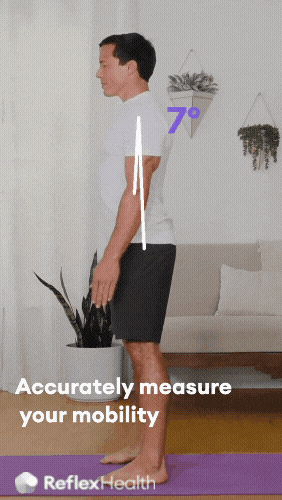Why you should measure shoulder range of motion
- The shoulder has the highest range of motion of all the joints in the human body
- We rely on it for many movements in our day to day activities, but often take it for granted
- Reduction in your shoulder range of motion can have big impacts on your physical and mental health
- Slow progress is one of the biggest reasons people don’t complete rehab for their shoulder injuries
- Using data to track recovery helps you ensure you are on the right treatment plan
- Measuring range of motion will show that you are progressing in recovery and encourages you to reach your goals
Our shoulders are capable of an impressive range of motion (ROM). Through its various anatomical positions, a healthy shoulder can in fact complete a full circle – technically called circumduction. We rely on this range of motion for many of our daily activities, such as reaching something off a high shelf, grabbing a needed paper off the desk behind you, and even just getting dressed in the morning. When everything is working as it should, we use our full range of motion without even thinking about it.
Why shoulder ROM is important in detecting early signs of injury
When pain or injury strikes the shoulder, a loss of range of motion is often the first indication that something is not quite right. Maybe you struggle to get your arm behind you when getting your coat on. Perhaps you fell onto your arm and now can’t lift it above shoulder height. A loss of shoulder range of motion can have profound impacts on a person’s day-to-day life and should never be ignored.
Adhesive Capsulitis (Frozen Shoulder)
Take for instance Adhesive Capsulitis, more commonly referred to as Frozen ShoulderA condition where shoulder movement becomes very limited and painful. The cause is often unknown, bu More. While pain is often one of the first symptoms, stiffness and decreased range of motion are the hallmark signs of the disease. Specifically, a loss of range of motion into external rotationThe range of shoulder external rotation is one of the most important metrics in the field of general More, or rotating your arm outwards (example below), is the key diagnostic indicator for frozen shoulder [1]. It’s common for patients with frozen shoulder to quickly lose almost all external rotation.

If you are suffering shoulder painShoulder pain is any pain felt around in and around the shoulder joint. The shoulder is the most mob More, monitoring your range of motion can therefore help your health care providers identify the cause of your shoulder pain. In the case of frozen shoulder, if your shoulder won’t rotate outwards at all, then it’s highly likely you have frozen shoulder. An accurate diagnosis will then allow medical staff to provide the most appropriate therapy, helping improve your chances of a full recovery.
Acute shoulder injuries – impact & trauma
Monitoring range of motion can also be a vital part of diagnosing an acute shoulder injury. Say, for example, you fell off your bike and landed on your shoulder. You generally came out of the accident alright, but you’re struggling to move your shoulder. When you lift your arm up to the side, you can only manage about 30 degrees before you’re struck with severe pain. Not only is it painful to try to lift your arm, but it feels like you simply can’t. This lack of range could indicate that you have torn your rotator cuffThe rotator cuff is a group of muscles and tendons that attach the shoulder blade to the upper arm b More.
Active vs Passive Range of Motion
A key diagnostic factor of rotator cuff tears is a difference between active and passive range of motion [2].
Active range of motion is how high you can lift your arm normally.
Passive range of motion is how far someone else could move your arm when it is relaxed.
Rotator Cuff Tear
A quick test of your active versus passive range of motion would indicate the possibility of a rotator cuff tear. While you are unable to lift your arm, you ask your friend to check your passive range. Your friend lifts your arm easily, and you only feel minor pain. The outcome of this quick test can aid your doctor or physiotherapist in identifying that further tests and treatments are likely needed for your rotator cuff.
Why shoulder ROM is important during recovery
Measuring your range of motion at the start of rehabilitationRehabilitation is the process of helping a person regain strength and function after an injury. This More is the first thing your physiotherapist will do.
Where measuring shoulder range of motion really becomes important is during recovery. If you are recovering from a shoulder injury or surgery, trying to regain your range of motion is often the first hurdle. In fact, measuring your range of motion at the start of rehabilitation is the first thing your physiotherapist will do.
The first measurement gives you a baseline to work from. The first test will help identify appropriate treatment plans. For example, if you only have a few degrees of shoulder movement, then you will need to start with very basic exercises, whereas if you have about half of your normal range, you may be able to progress to medium-level exercises pretty quickly. Most importantly, measuring range of motion will help you identify if your treatment plan is working. If you are consistently sticking to your exercise plan and advice from your therapist, then you should see a gradual increase in your range of movement. However, there is never a one-size-fits-all approach for rehabilitation. So, regularly monitoring your range of motion is critical to identify problems with your treatment plan.
If you are not noticing improvements in your range, you know that you and your therapist need to make changes in your exercise prescription. The sooner that problems are identified, the sooner you can get back onto the right track!
Download Reflex Health on iOS
References:
-
The external rotation test in the diagnosis of adhesive capsulitis-https://pubmed.ncbi.nlm.nih.gov/20506951/
-
Rotator Cuff Tears – https://www.physio-pedia.com/Rotator_Cuff_Tears

